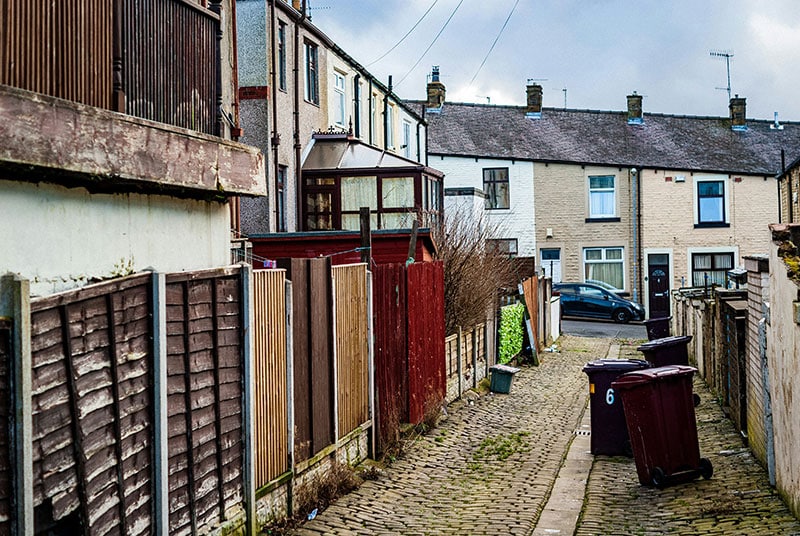What are the financial implications of managing asbestos in a rental property?
The extremely widespread use of asbestos at its peak popularity in the UK – from around the 1950s until the 1980s – led to the now-banned mineral being incorporated into all manner of products that found their way into residential buildings.
Unsurprisingly, then, asbestos-containing materials (ACMs) – such as asbestos cement roof tiles, wall cladding, and insulation – remain present in great quantities in domestic structures dating to before the final ban on asbestos in 1999.
Asbestos being present to such a strong degree in many older rental properties in the UK, can bring about a significant financial burden for landlords and property managers when it comes to managing the material.
So, if you own a residential property in the UK that you make available for rent, what are the key financial aspects of managing asbestos in such older buildings, ranging from identification to removal? Furthermore, how will these costs impact on your rental operations?
Below, we have set out a comprehensive guide.
How much does an asbestos survey cost?
An asbestos survey is likely to be effectively mandatory for your rental property, given that landlords are classed as “dutyholders” under Regulation 4 of the Control of Asbestos Regulations 2012 (CAR 2012). We have previously written in detail about the factors that make an asbestos survey effectively a legal requirement for dutyholders.
However, the question of how much landlords might reasonably expect an asbestos survey to cost can be a source of confusion. You might have approached a few asbestos surveying companies, and been quoted drastically differing prices for the same property and survey type.
Below are the current two types of asbestos survey:
- The management survey, which is meant to help a dutyholder manage ACMs during the normal use and occupation of their property. This type of survey allows for an asbestos register and an asbestos management plan to be put together by the dutyholder.
- The refurbishment or demolition survey, which is meant to locate and identify all ACMs – including those hidden within the fabric of the building – so that they can be removed, as far as reasonably practicable, prior to any major refurbishment or demolition work at the site.
The specific type of asbestos survey requested could certainly be one factor in the price. For example, as we previously outlined in our in-depth guide to asbestos survey costs, while an asbestos management survey for a two or three-bedroom semi-detached house might cost around £250 to £395 as of 2024, a refurbishment or demolition survey on the same property may be expected to be around £295 to £495.
However, such factors as the property size, type, and location will also contribute to the price. You should also take care to clarify whether the asbestos survey price you are quoted includes the laboratory testing of samples.
Ultimately, by investing in a thorough and professional asbestos survey for your rental property, you can greatly help to avoid higher costs later. So, an asbestos survey is not a service where you should ever be making the headline price your sole priority.
What are the costs of asbestos removal or management?
Asbestos removal is an inherently complicated task, with many different variables affecting what is required for each project, and the associated costs. Examples of these variables include the specific extent of the contamination, as well as the locations of the ACMs that need to be removed.
As we detailed in our previous guide to asbestos removal costs at Oracle Solutions, there are many different cost elements involved in this specialised process. These include overheads and profit, as well as the costs of the removal team, removal materials, removal equipment, any required testing (such as asbestos air monitoring), and the removal of asbestos waste.
It is important to bear in mind, of course, that the removal of all asbestos from your rental property might not be the only option you have for managing ACMs in your building. You might, for instance, consider encapsulation, which entails sealing the surface of an ACM to prevent potentially extremely dangerous fibres escaping from the material in the future.
We have explained in the past that asbestos encapsulation won’t necessarily be the most responsible way to manage ACMs in certain circumstances. ACMs that are in good condition, and not in a location where future disturbance is likely, tend to suit encapsulation. If, on the other hand, certain ACMs are severely damaged or deteriorated, as well as in a high-risk part of the property for future disturbance, removal will typically be the best option.
Again, it is crucial to emphasise that cost is not the only factor you should account for when deciding how to manage asbestos at your site. Encapsulation does, though, typically cost around 25% the amount that removal does – so, cost-effectiveness could still be something to think about.
How does asbestos management affect property value and rental income?
One might imagine that, given the well-established notoriety of asbestos today – the mineral being a now-outlawed carcinogen, still responsible for around 5,000 deaths every year in the UK – there could be some scope for the presence of asbestos to affect the given property’s value.
However, it is also important not to overemphasise this aspect. Asbestos is believed to pose negligible risk to health if it is in good condition, undisturbed, and properly managed. Furthermore, the substance’s use was so widespread that to this day, almost any rental property in the UK constructed prior to the year 2000, is likely to contain asbestos.
These factors could lessen any adverse effects the existence of asbestos in your property has on the value of the property and the rental income it can generate. After all, if the neighbourhood of your rental property is largely dominated by homes built during the second half of the 20th century, the asbestos situation in your building may not drastically differ from the situation for other houses nearby that prospective buyers or tenants may be considering.
However, it is also true that as a landlord, you are required to inform tenants about the presence and condition of ACMs in your rental property. Otherwise, you could face significant legal consequences, potentially including fines and liability for any health issues that occur due to asbestos exposure. An asbestos report – produced by the legally required asbestos survey – will need to be shared with current and prospective tenants.
If would-be tenants are deterred from renting your property due to the asbestos situation in it, this – in theory – could exert downward pressure on the rental income you are able to generate from the property. This simply further underlines the importance of proactive, safe, and legally compliant asbestos management, which will almost certainly be money well spent.
Are there financial assistance schemes or grants available for asbestos management?
You may be on the lookout for sources of financial help with forms of asbestos management such as the removal of the substance from your rental property. If so, below are some of the possibilities you might consider:
Government grants and subsidies
Unfortunately, as we have written about in the past, there has not been an abundance of grants and schemes at national level over recent years with a focus on asbestos. Of course, the situation could conceivably change in the future.
In the meantime, the best course of action would probably be to seek out the asbestos section of your local council’s website, perhaps using the GOV.UK site’s postcode lookup tool as a starting point. Doing so may lead you to information on asbestos services and removal near you.
It might be possible from time to time to find local authority grants, heritage grants, energy efficiency grants, and/or housing grants that have some degree of relevance to asbestos management. Naturally, if you do come across a scheme of interest, you will need to satisfy the relevant eligibility criteria and follow the necessary application process.
Tax deductions and relief
The scarcity of grants available in the UK for asbestos management could make any possible tax deductions and relief especially helpful as you seek out ways to make dealing with asbestos in your rental property more affordable.
Since the passing of legislation in 2001, businesses have been able to obtain a tax rebate in relation to the removal of ACMs from their sites. You can click through to read more about how this tax relief for asbestos removal or remediation works, in addition to taking a look at information and guidance manuals on the GOV.UK site for the latest information.
How should landlords budget for ongoing asbestos management?
As a landlord for a property where asbestos is known or suspected to be present – in other words, almost any building dating to before the 1999 ban on all types of asbestos in the UK – it will be essential to account for asbestos in your long-term maintenance plan.
Alongside budgeting for ongoing monitoring and management of asbestos, it would be a good idea to create a reserve fund for any unexpected asbestos-related expenses.
It is also worth bearing in mind that the UK’s asbestos regulations might yet become even more stringent over the coming years, in light of intensifying political pressure from campaigners urging the phased removal of asbestos from the country’s buildings. So, you should be seeking to build enough flexibility into your budget to accommodate any future regulatory changes.
What are the legal and financial risks of failing to properly manage asbestos?
With landlords being regarded as “dutyholders” under the aforementioned CAR 2012, they can be at risk of serious legal and financial consequences if they do not comply with the requirements laid out by this legislation.
A landlord failing to have an asbestos management plan in place could result in a fine of up to £20,000 being imposed, or a prison sentence of up to six months. Serious violations of the regulations could lead to an unlimited fine and/or imprisonment for up to two years.
Conclusion: landlords need to be proactive and budget-conscious in their asbestos management
The need to manage asbestos carefully and compliantly in a rental property where the now-banned substance may be present, brings a wide range of financial implications. These encompass the likes of asbestos surveying costs, removal expenses, impacts on property value and rent income, and legal risks.
The great news is that by taking a proactive approach to asbestos management at your rental property, you can greatly help to avoid unexpected costs and legal complications. It is crucial for landlords to budget wisely and to stay informed about the latest asbestos regulations, so that they are in the best position to protect their tenants and their financial investment.
To request your fast and free quote for any of our asbestos services that could help take the stress and hassle out of managing asbestos across your property portfolio, please don’t hesitate to contact the Oracle Solutions team today.

Written by Mark Carter
Mark Carter is a renowned expert in asbestos management, offering clients vital guidance on compliance and safety. His expertise is invaluable for navigating asbestos regulations, ensuring both safety and legal adherence. Mark's role is central in providing effective asbestos-related solutions, helping clients achieve their business objectives with an emphasis on regulatory compliance and safety in asbestos management.

